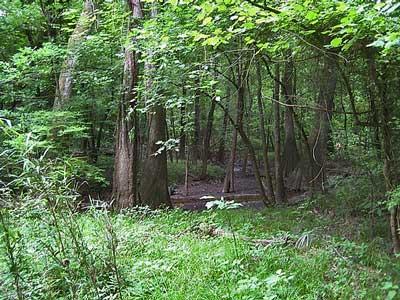The names of most areas in the National Park System are usually pretty descriptive of the main features of the site, and that's the case for the Big Thicket National Preserve in southeast Texas. The term "Big Thicket" had been applied to the region by early settlers long before there were any thoughts of a park in the area, and it certainly fits the landscape: the woods and swamps are "big" and in places the vegetation is thick indeed.
It's also an easy place to get lost.
Unless you're outdoors-savvy, landmarks are subtle, and the terrain is mostly flat, so this isn't a part of the country where you can just climb to the top of the nearest ridge and get your bearings. It's an interesting place to visit, and navigation isn't a problem if you stay on one of the designated trails. If you decide to strike out on your own into the depths of the Thicket, however, it's a good idea to pay close attention to your route.
Designation of this area as a "national preserve" also means that hunting is allowed in much of the area for part of the year, and hunters can sometimes become so focused on their search for game they forget that part about "paying attention" to their surroundings. That was the case some years ago on a late fall day in the Thicket.
A good rule of thumb anytime you realize you're lost in the wild is to stay put and wait for help. The files of search and rescue teams are filled with accounts of searches that involved huge numbers of people, lasted for days, and cost a king’s ransom, all because the lost person tried unsuccessfully to find his or her way back to safety. In the process, the disoriented victim kept getting further and further away from the area where rescuers were looking.
In the case of the lost hunter in the Big Thicket, daylight was fading and a heavy cloud cover meant there was no navigational help from the setting sun. Which way to go to get back to his truck? The man realized he didn't have a clue, so he wisely decided to cut his losses, stay put, try another good technique… and hope for the best.
There was at least some consolation in the fact he hadn't seen any game all day—he hadn't fired a shot and still had all his ammo. Employing the universal signal for distress, the hunter fired three rounds from his shotgun into the air, waited a few seconds, and then repeated his mini-salvo.
At first the only result was a raucous chorus from a flock of crows disturbed by the gunfire, but then the hapless hunter was relieved to hear three distant shots fired in apparent response to his signal. After several more exchanges of blasts, the hunter was out of shells, but each succeeding round of shots seemed to be getting closer to his position, so it seemed safe to commence with the “hollering” phase of his impending rescue.
His loud “halloooooo . . .” was met with a similar response, and in due time, the two men managed to join forces just as twilight faded into darkness. I heard about this caper after its conclusion, so the following is my paraphrase of the conversation that ensued when the two men met in the depths of the forest.
Hunter #1: “Man, I’m sure glad to see you!”
Hunter #2: “Same here. It’s a good thing you heard my signal.”
“Sure is. Hey, it’s just about dark. Mighty glad to see you brought a flashlight.”
“Yep, It can get a bit spooky out here at night,” the second man replied.
“Well, let’s get started, " Number 1 suggested. "Where’d you leave your truck?”
“Out on the state road, not far from that pipeline crossing. I hope yours is closer, and you can give me a ride back to my rig after we get to yours. Where did you park?”
“Sounds like it's not far from yours," said Number 1. "I'm surprised you didn't see it. Go ahead, I’ll follow you since you’ve got the light.”
The second hunter sounded a bit puzzled by this suggestion, but little more conversation got to the root of the problem. Both men were lost and each assumed the other had been sent to look for him. Finders may be keepers, but in this case, the only thing the finder could keep was company with his co-loser.
After realizing the irony of their situation the two men were at least smart enough to avoid wandering around all night in the dark. They built a fire, spent the night swapping hunting tales and probably a few lies about the “one that got away,” and were safely located by real searchers the next morning.
A friend of mine who spent years exploring the Big Thicket noted that maps of the area were pretty sketchy in the early days of the park, and he devised his own practical definition for when a situation qualified as being "lost" in that area.
He said he wasn't "lost" unless he missed a meal he hadn't intended to skip. Otherwise, he was just "detained" for a while.
The approach of cooler weather brings a nice time of year to enjoy the Big Thicket. Just try to make sure you don't get "detained."
This story is adapted from the book Hey Ranger! True Tales of Humor and Misadventure from America’s National Parks © Jim Burnett and Taylor Trade Publishing, used by permission.




Comments
I've been 'detained' a few times... more often in E. Texas than the decade spent in Alaska. E Tex has very few landmarks, and in the deep woods, it's even worse.